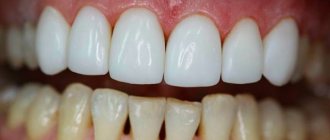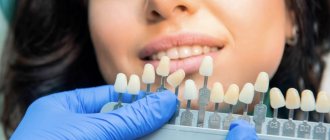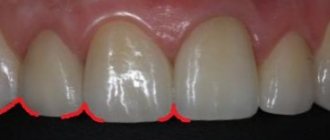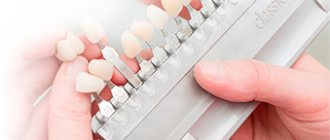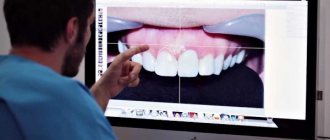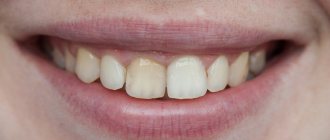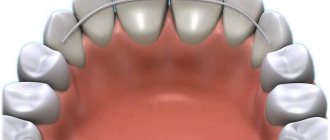If you want to improve the appearance of your smile, if you don’t like something about it, but you cannot accurately and correctly formulate what exactly, if you want to talk with your dentist about the aesthetics of your smile in the same language, then the following note is just right for you.
Nature (or God... depending on your views on life) has made us different. And our originality and uniqueness have its own charm. But what to do when this uniqueness goes too far beyond our ideas of beauty? How to formulate your claims to nature (and perhaps to the previous intervention of dentists)? To assess the aesthetic component of our face, lips, teeth - everything that gives rise to a beautiful, harmonious smile, it turns out that there are many parameters. This is what dentists use (at least should use) when planning changes in your appearance. Since there are very, very many different nuances, and I do not have the task of making each of you an expert in the field of aesthetic dentistry , we will focus on the ten simplest and most important.
Parallelism of horizontal landmarks.
One of the most important signs of a harmonious smile is the parallelism of imaginary lines: the interpupillary line (in the picture there is a blue line connecting the right and left pupil of the eye) and the lip line (in the picture there is a red line drawn between the corners of the mouth).
Both of these lines should also be parallel to the lines connecting the edges of the central incisors (green) and the incisal cusps of the canines (blue)
Gum level.
A smile looks attractive and more aesthetically pleasing , in which the line connecting the necks of the teeth (shown in dotted lines) repeats the line of the upper lip, and the level of gum exposed when smiling is symmetrical on the right and left. At the same time, with a maximally open smile, only the gum “triangles” between the teeth and a small strip of gum above them (no more than 2-3 mm wide) should be noticeable.
Thus, the gums around the upper teeth, upper and lower lips form a kind of frame for your smile. If the “picture” is not visible behind the frame, then such a smile will not look attractive.
Excessive visualization of the gums (the so-called “gummy smile”) is most often eliminated with the help of surgery, orthodontic treatment, as well as cosmetic interventions (for example, Botox injections into the upper lip, upper lip augmentation, etc.).
How much does a perfect smile cost?
The cost of a perfect smile depends on the procedures that will need to be completed to achieve the desired result. If we are talking about hygienic cleaning and whitening, then, depending on the technique and level of the clinic, the price ranges from 10,000 to 37,000 rubles for both services. If we talk about the price of lumineers in Moscow, it starts from 35,000 per tooth. Depending on the material used, the cost of ceramic veneers starts from 3,000 to 50,000 rubles or even more. Orthodontic treatment, prosthetics and implantation are procedures that require taking into account many factors on which the price depends.
Publisher: Expert magazine about dentistry Startsmile.ru
Vertical symmetry and midline.
A line passing through the center of the face should pass exactly between the central incisors of the upper jaw. The discrepancy between these lines causes a feeling of disharmony even with a quick glance at your smile from the outside. In this case, it is not at all necessary that it also passes between the central lower incisors. Firstly, a complete match is rarely found, and secondly, this in no way affects the aesthetic perception of your smile when viewed from the outside.
How can digital technology help transform your appearance?
Our clinic actively uses Digital Smile Design technology (“digital smile design” or DSD, read as “digital smile design”) in combination with the principles of Dental Face Lifting (“dental facelift”). Based on the capabilities of digital computer modeling, we restore the ratio of the proportions of the face and teeth according to the “golden ratio” principle using orthopedic and orthodontic structures (for restoring teeth with the help of dentures, as well as correcting the bite, respectively).
We recreate the correct anatomy of the teeth, normalize the chewing load, restore youth to the facial contour and get exactly the smile that suits the patient best.
Every person is unique. Therefore, there are no template solutions. The patient’s personal information is loaded into the Digital Smile Design program - his photographs, computed tomography and intraoral scan data. Based on them, the doctor creates a model of the future smile, taking into account all individual anatomical features. And then the models are transferred to the articulator in order to verify the bite relationships and make adjustments if necessary.
Digitally designed veneers transform your smile and look more natural
All the necessary proportions and measurements are included inside the program. She suggests how best to work out the aesthetics and draws up a step-by-step treatment plan.
Making veneers is a multi-stage and expensive procedure; the cost of an error is quite high. Therefore, it is useful for all participants in the process - the patient, the orthopedic surgeon and the dental laboratory specialists - to have the same information, which cannot be interpreted in their own way. It is this consistency that careful planning of the treatment process can achieve.
The DSD program transmits clear data backed up by 3D images to the laboratory. Everything is taken into account: the shape, shade, height and width of future restorations, their exact positioning and relationship with the gum. Distances are adjusted to fractions of a millimeter, and the color of future veneers is selected on a scale taking into account the color of the patient’s eyes and skin.
This means that the risks of the human factor are eliminated. There will be no errors in color perception or distortions in shape. The laboratory, the orthopedic dentist and, of course, the patient will not differ in their expectations of the result.
Ceramic veneers
natural look requires turning Price: from 25,000 rub. Price: from 25,000 rub.
Zirconium veneers
stronger and thinner turning is required Price: from RUB 25,000. Price: from 25,000 rub.
Ceramic composite
light and durable turning is not always required Price: from 15,000 rubles. Price: from 15,000 rub.
Lumineers
the thinnest veneers do not require turning Price: from 65,000 rubles. Price: from 65,000 rub.
We create beautiful smiles! Veneers and lumineers are non-staining and protect teeth. 3D modeling is included in the price!
Free consultation
"Golden proportion".
The principle of the golden proportion in relation to a smile in aesthetic dentistry is that when looking at it from the front strictly in the center, the ratio of the apparent width of the front teeth should be approximately the following - 0.6 (width of the canine): 1 (width of the lateral incisor): 1.6 (width of the central incisor ).
As can be seen in the photo, the width of the visible part of the remaining teeth (4s, 5s) should consistently decrease, creating a sense of perspective.
Reasons for the development of malocclusion
Abnormal bite can occur under the influence of the following factors that provoke its development:
- In children: thumb sucking and prolonged use of a pacifier.
- Bad habits such as putting things in your mouth and chewing them.
- The first baby teeth do not fall out for a long time.
- Bruxism.
- Wide gaps between the elements of the dentition.
- Large gaps between teeth.
- Complex respiratory diseases.
- Pathological processes in the body that negatively affect bone development.
- Poorly developed diet without solid food.
- Side effects after prosthetics.
- Loss of most of the elements of the dentition.
Many people with malocclusion often wonder: when is orthodontic intervention necessary to correct the situation? The situation can be corrected only after preliminary diagnostics. In some cases, it is needed if there are no obvious defects. Below we will consider cases when such measures cannot be avoided:
- Direct closure of teeth during physiological occlusion, when it causes increased abrasion of tooth enamel.
- With a progenic bite, a short upper lip makes the upper row of teeth too noticeable, spoiling the aesthetics of the smile.
- If a person has too large front teeth of the correct shape with a progenic or biprognathic bite.
- Impaired diction with mesial occlusion, when the lower jaw of a person is underdeveloped, which contributes to the overlap of the upper front teeth with the lower incisors.
- With open pathology, there is no contact between most of the teeth when the jaws close. The anomaly is classified into lateral and frontal. The treatment method for each form is selected by the orthodontist individually for each patient.
- With deep pathology, tooth enamel is quickly erased due to complete overlap of the lower teeth.
- In a crossbite, one of the jaws is partially unformed. The situation is being corrected through comprehensive measures.
You can determine a person’s correct bite using photographs or by contacting a professional orthodontist.
Proportions of the tooth.
The central incisors of the upper jaw always attract special attention, because... best visible when talking and smiling. Therefore, it is very important that their proportions are correct. The most harmonious looking teeth are those with a ratio of tooth width to length of approximately 0.7-0.8: 1
However, at different ages this ratio may change. Due to the physiological wear of teeth in older age, this ratio tends to be 1:1. Therefore, if you want to “rejuvenate” your smile, you usually need to increase the length of the tooth.
Why is it important that occlusion is correct?
Incorrect occlusion creates a lot of problems for a person.
- Chewing function is impaired. Poorly chewed food, entering the digestive tract, causes disturbances in all its departments.
- Damage and abrasion of dental elements and injury to the soft tissues of the oral cavity may also occur.
- In addition to organic problems, improper occlusion develops psychological disorders in a person. Typically, the jaw looks unattractive and disrupts the symmetry of the face. A smile looks ugly. Problems appear with the pronunciation of sounds. All this forms complexes and develops self-doubt.
A photo of a side view before and after correction of pathological bites clearly demonstrates how much a person’s face changes after correction.
Interincisal angles.
Interincisal angles are the spaces between the cutting edges of the anterior group of teeth.
With the harmonious construction of teeth, these angles should gradually increase from the center to the periphery: from a small closed angle between the central incisors, to a more direct and even open angle between the 2nd and 3rd teeth.
Tooth wear leads to a decrease or complete absence of interincisal angles, which makes the patient look older when he smiles.
At the same time, “female” teeth are characterized by rounded corners of the incisors, while “male” teeth are characterized by straighter ones.
Zenith of the gingival contour.
The zenith of the gum is its most concave part around the neck of the tooth (indicated by dots in the photo).
The level of zeniths near different teeth in the smile zone should be at different levels. For the central incisors and canines - approximately at the same level (or slightly higher for the canines), for the lateral incisors - slightly lower than both (as shown by the lines in the photo). At the same time, it is equally important that the zeniths on symmetrical teeth are at the same level. This is especially important to consider if this area becomes noticeable when smiling. When even with the most open smile the gums are not exposed, then there is no serious need to set the zeniths perfectly symmetrically.
In this case, attention is drawn to the too low zenith level on tooth 12; it is significantly lower than the symmetrical tooth 22. There is also a slight difference in the position of the zeniths on the central incisors (teeth 11 and 21). As a result of treatment, these shortcomings were eliminated, as can be seen in the first photo.
Choice number 2: aesthetic braces made of sapphire and ceramics
Those who definitely can’t be embarrassed about photos of smiles with teeth are people who have highly aesthetic braces made of ceramic or artificial sapphire. Snow-white or almost transparent plates look like precious jewelry or a fashion accessory. They are neat, compact, smooth. And if they also come with a white-painted metal arch, the systems become almost invisible in the oral cavity.
Which celebrities have been seen wearing such orthodontic devices? In fact, the list of star patients can be continued endlessly. Here are just a few of them: Cristiano Ronaldo, Regina Todorenko, Timur Rodriguez, Paulina Andreeva, Danya Milokhin, Tom Cruise, Faith Hill, Prince Harry, Fantasia Barrino, Niall Horan, Cristiano Ronaldo, Estelle, Carrie Underwood.
Some people don't even think about being embarrassed about wearing braces.
Are you also thinking about installing aesthetic ceramic braces, but don’t know which one to choose? Especially for you, the editors of the UltraSmile.ru portal have prepared a review of the most popular models.
American actress and fashion model Dakota Fanning also wore them. The girl had serious bite pathologies, so she additionally had to undergo treatment using bulky orthodontic extraoral appliances, which she was not at all embarrassed about. In addition, the young actress loved to emphasize her individuality and the presence of braces in every possible way, choosing multi-colored ligatures to match them.
And Danny Glover installed aesthetic braces at the age of 62, which once again proves that it is never too late and not at all scary to correct your bite and improve your smile. Nobody will judge you for taking care of your health.
Position of cutting edges.
The cutting edges of the central group of teeth are also located at different levels. For the central incisors and canines - approximately at the same level, for the lateral incisors - slightly higher (as marked by lines in the photo).
Again, due to the abrasion of teeth with age, the cutting edges of the teeth become at the same level, the line connecting them takes on a straight rather than convex appearance, and sometimes (with increased pathological abrasion) even concave. Therefore, to make a smile more “youthful,” you need to return the relationship of the cutting edges to a harmonious one.
It can also be noted that the dominance of the central incisors over the lateral incisors and canines also gives the smile a more youthful appearance.
The dominance of the canines, their sharp, prominent cutting cusps, make the smile more aggressive. This effect is based on the fact that in nature, long, sharp, well-developed fangs are characteristic of predators, whose entire philosophy of existence is based on aggression towards their prey.
Choice #1: Lingual Braces
Such structures are completely invisible to others, as they are attached to the inside of the dentition. And this allows you to keep the fact of undergoing treatment a secret, even if you are constantly in public and openly smiling. Although some celebrities do not hide this at all, because today taking care of your health is not only useful, but also fashionable. For example, Victoria Bonya, who decided to correct her bite at the age of 36. The actress and TV presenter openly showed photographs of lingual plates made for her straight from the dentist's office.
Victoria Bonya decided that it’s never too late to change
Singer Vera Brezhneva also wore lingual systems. According to one of the most beautiful women in Ukraine, her wisdom teeth erupted, which disrupted her bite, so she had to take action. True, Vera notes that while adapting to the systems, she experienced slight problems with diction. However, it is important to understand that in the case of devices that are attached to the tongue, this is a completely common phenomenon that gradually goes away a few weeks after installation.
All the pros and cons of lingual systems are in a feature article on the website.
Interdental gingival papillae.
The gingival papilla is the part of the gum that fills the interdental space (marked with lines in the photo).
The location and appearance of the papillae is determined by the underlying bone, which has exactly the same contour. In the most optimal option, the tops of the gingival papillae are located as in the photo (marked with dots) - between the central incisors the gingival papilla is longest, and gradually its length decreases towards the periphery. Moreover, they should all have a healthy appearance - a triangular shape with a sharp apex, pink color, no swelling.
With various periodontal diseases, as well as with improperly performed restorations, the gingival papilla may become inflamed, acquiring a darker (or even bluish) color, losing its pointed shape, or may even disappear completely. At the same time, unaesthetic black spaces form between the teeth.
This is what the main, but still far from complete, list of parameters that need to be assessed and taken into account when planning and creating an ideal smile looks like. aesthetic dentistry does . Now you can evaluate for yourself how close your smile is to ideal. And I hope that this note will help you better understand what exactly you would like to change and improve. After all, this will greatly facilitate mutual understanding between you and your dentist.
PS See the photographs of clinical cases of my patients presented in this note in detail in the photo gallery section of the site, where details about aesthetic dentistry and modern dental technologies for restoring an ideal smile.
How to get the perfect smile?
The minimum required set for a perfect smile is a toothbrush, toothpaste, floss and visits to the dentist twice a year. Unfortunately, today few people fulfill these requirements, and at a fairly young age people already suffer from diseases of the oral cavity, in which the smile is far from ideal. Even so, dentists use techniques to improve the aesthetics of your smile.
If you are unhappy with your smile, your dentist can help you fix it. First of all, determine what exactly you don't like. Depending on the problem, different treatment methods are used. In some cases, it is enough to do professional oral hygiene; in others, whitening will help.

